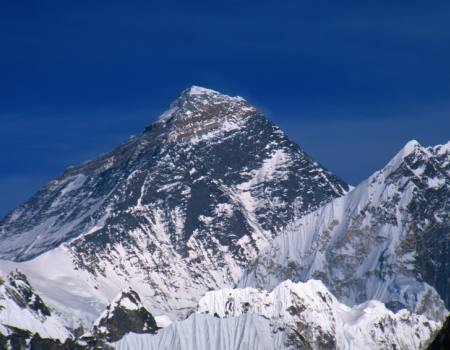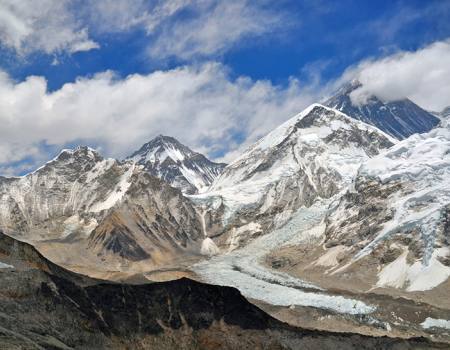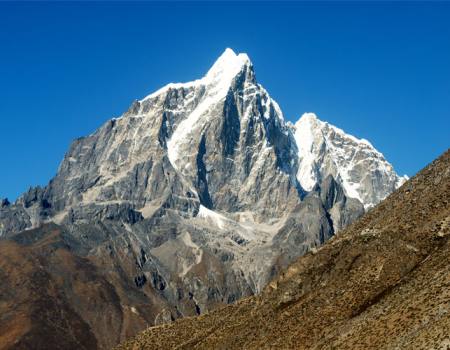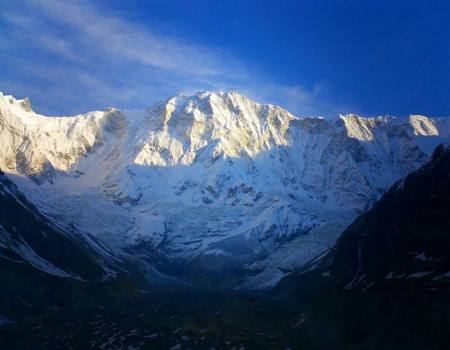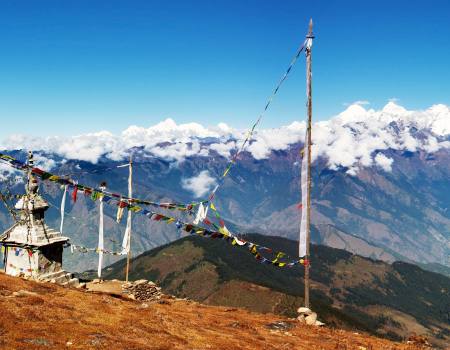- Email [email protected]
- Phone +61 448 783 343
Mountains and Monasteries Trek - 20 Days
A spectacular lodge trek through some of the less travelled parts of the Everest region combined with the lower parts of the traditional Everest Base Camp route. This is a perfect chance to experience Sherpa culture, particularly their religion, as many significant monasteries can be visited en route. While the mountain scenery is breath-taking the high point of this trek, at just under 4000 metres above sea level, is significantly lower than the high point of the traditional Base Camp trek. This trek is especially good from mid February to early March when the hills are a riot of colour when the rhododendron trees come into bloom.
Key Information
-
Trip Duration 20 Days
-
Price fromUS$ 1836 | Contact Us
-
Destination Nepal
-
Trip Difficulty Moderate
-
Trip Style Trekking
-
Accomodation Hotel and Resort
- Day 01 :Arrive Kathmandu The flight into Kathmandu is special. The final hour of the flight gives you a glimpse of the Himalaya rising above the clouds. The landing at Kathmandu is spectacular as the plane swoops down into the bowl shaped valley and skims over villages, rice fields and finally the urban sprawl. After your first taste of Nepali bureaucracy and the haphazard baggage claim you will exit to be met by our Kathmandu representative who will be your main contact while you are in Kathmandu so make sure that you use him to answer any questions you may have. The bus ride into the city to your hotel should take about twenty minutes. The traffic will seem chaotic – welcome to the third world! Your hotel will be in or near the heart of Thamel – the main tourist area of Kathmandu. Everything you will need to buy or eat can be found within a few minutes walk of the hotel. Our representative will be organising shopping trips for buying last minute equipment but for now relax in the hotel and leave the crowded streets until tomorrow.
- Day 02 :In Kathmandu Allowing for jet lag it may be hard to be up early but do try so that you can experience a less crowded Kathmandu. Breakfast at the hotel won’t appear until after 7 am so take the opportunity for an early morning stroll around the streets as Kathmandu wakes up. Just be sure to remember the way back to the hotel. One of the best morning walks is up to the hilltop site of Swoyambunath, the monkey temple. It can be tricky to find but if you follow the trail of locals spinning prayer wheels you should find it.
Your representative will meet you for breakfast and organise the shopping trip for those that still have gear to buy. The main aim of today is to get everything ready for the trek and to stay healthy so give the local street food a miss. We will distribute your duffel bags ready to receive all of your kit. You need to pack these with all of your personal gear ready for the early departure tomorrow. Whatever you do, don’t pack any sharp objects in your day pack as the security check at the airport is quite efficient. Try to get an early night so that you are fresh for the first day trekking. - Day 03 :Kathmandu to Phaplu This is the big day. You will be advised of the scheduled departure time of the flight. It will probably be around 8 am so departure from the hotel will be about 6 am. Make sure that you have plenty of drinking water for the day, before you leave Thamel. Eventually your flight will be called, unlikely to be on time, and you can start the adventure. The aircraft will be a 15 seat Twin Otter, un-pressurised, flying at an altitude of about 3700 metres meaning that you will get a close-up view of a lot of the countryside that you will be flying over. After crossing over several ridges, which are just below 3700 metres, you will turn left into the valley of the Solu Khola, the river that flows from the slopes of Numbur, the mountain that dominates the skyline to the north. On the far side of the valley you will soon see the landing strip at Phaplu, your destination. The landing at Phaplu is exciting for first timers but it is, in fact, one of the safest landing strips in the mountains.
The rest of the staff will be there to meet you and grab your duffel bags for the few minutes walk to the lodge that we will use for the first night. After lunch the rest of the day can be spent exploring the local area which can include a walk of about an hour to Salleri, the headquarters of SoluKhumbu district.
- Day 04 :Phaplu to Junbesi This is the first day of real trekking. Have your duffel bag packed and ready for the porters before breakfast and make sure that you have all of your daily needs packed in your back pack. The trail leads north through mixed farming land alongside the Solu Khola which is crossed by bridge at the hamlet of Beni. The trail then rises steadily towards the village of Junbesi which is reached in a further three hours. As there are no suitable lodges en route a packed lunch will be provided. Keep an eye on the hillsides as barking deer may be seen grazing along this section of the walk. Junbesi is an important Sherpa settlement, one of the original places that were settled some 500 years ago. Many old houses are still standing in the centre of the village and the village gompa is a particularly fine example of Buddhist architecture.
- Day 05 :Around Junbesi There is so much to do around Junbesi that a full day here is planned. The attractions include the major Monastery at Thupten Chholing, which is just over a hour’s walk from Junbesi. From here there are several options for walks in the hills above the monastery. Alternatively you can return to Junbesi and visit the school here that was established by Sir Edmund Hillary.
- Day 06 :Junbesi to Manidingma Leaving Junbesi, the trail rises above the path from Phaplu through some beautiful stands of natural forest. As you leave the forest behind the views open out until, rounding a bend, you are treated to a Himalayan panorama that includes Everest. The trail contours around to the settlement at Sallung before steadily descending to the village of Ringmo. Have a short break here and a quick cuppa before tackling the climb up to Tragsindho La, which at just over 3000 metres, is your first taste of altitude. The climb is well worth it as the main Himalayan range opens out once more as you cross the pass.
Lunch will be just below the pass near to the large Buddhist Tragsindho monastery. Feel free to explore the monastery during the lunch break. After lunch the trail heads down hill through farm land to the large Sherpa village of Manidingma where you will spend the night. - Day 07 :Manidingma to Puiyan. From Manidingma the trail drops down to the DudhKhosi, the river that drains the slopes of Everest. The crossing will be your first experience of a suspension bridge strung high over the raging torrent. Watch out for trains of donkeys carrying loads as you approach the bridge, there isn’t room for you both. The next two hours are uphill but a short distance up from the river is the pretty village of Jubing where you can have a rest. Jubing is a Rai village; the Rai are one of the many different ethnic groups found in Nepal and they are generally found living just below the Sherpas in this part of the country. From the lunch spot it’s all uphill until just before you enter the large village of Kharikhola where lunch will be taken.
A steep uphill climb from the village takes you to Bupsa a small settlement high above the DudhKhosi. From here the trail undulates through stands of ancient forest until you reach the night spot at Puiyan. You will reach the small village quite late as this is one of the longer days on the trek - Day 08 :Puiyan to Cheplung Another day through the forest clothing the slopes above the river. There are few settlements on the way until the trail descends steeply to the village of Surkhe where lunch will be served. From here it is only an hour or two to the day’s destination Cheplung. Those who have the energy can climb the hill from here to Lukla, the site of the airstrip from where you will finally leave. This is a good place to stock up on anything that you may have forgotten to bring or to have a look at the comings and goings at the airport.
- Day 09 :Cheplung to Phakding. You have now joined the main trekking trail to Everest as you will see from the increased numbers of trekkers. You will pass through several settlements on the way to Phakding, the largest of these is Ghat which has some interesting prayer wheels at the side of the trail.
Cultural note
You are passing through country whose people predominantly follow Tibetan Buddhism as their religion. You will come across many signs of this including:
Temples (known locally as gompas). Feel free to have a look inside any of the gompas you see on your trek. Please take off your shoes before entering and leave a donation in the box that is usually provided.
Stupas (chhorten in the Sherpa and Tibetan language) Dome shaped structures that may contain relics such as remains of important religious leaders.
Stones carved with sacred mantras (usually om mani padme hum thus their common name of mani stones)
Prayer wheels ranging in size from hand held to the large ones found at Ghat. Some may even be turned by water or wind power. The wheels contain written prayers tightly packed inside and when the wheel is turned it is believed that the prayers are automatically said.
Prayer flags which will be seen flying at every turn. These are printed with prayers and mantras and, like the turning of the wheels, send the prayers aloft every time the wind blows.
Whenever you pass by one of these objects it is customary, if possible, to pass by so that the object is kept on your right. Similarly, if you are spinning a prayer wheel always do it in a clockwise direction.
After Ghat, it is not too far to go before reaching the river side hamlet of Phakding. As this is the normal first stop for Everest treks there are a large number of lodges in the village, the one that we are using is recently built and very comfortable. - Day 10 :Phakding to Namche Bazar Most of the morning is spent walking close to the river. The trail passes through a number of settlements. In particular look for a large waterfall near the trail at Taktok. You will be travelling through pine and rhododendron forests but in the clearings you will start to get views of the snow peaks that line the route. Look for Karyolung on the left hand side and Kusum Kanguru (the Australian peak?) to your right. Up ahead you will start to get glimpses of Thamserku and Kangtega.
Just beyond the village of Monjo is the entrance gate to the Sagarmatha National Park. Your guides will complete all of the formalities here but you must all enter as a group.
Lunch will not be far away. Normally this is taken at one of the lodges atJorsale, and then it’s time to relax before tackling the steep climb up to Namche Bazar.
The start of the climb is at the confluence of the BhoteKosi and the DudhKosi and is reached by crossing the river on a large and airy suspension bridge. Make sure that no yak trains are approaching before starting to cross as it is quite narrow. Take a moment half way across to look upstream for glimpses of the mountains.
The climb can take from one hour for the super fit to three hours for those preferring a more measured approach to Namche. Take your time as there is no real need to hurry. Be sure to drink plenty of water on the climb and stop for rests if you are feeling the altitude. The initially steep and rocky trail gives way to a more gentle path that winds through pine and rhododendron forest with clearings giving occasional views of the mountains. These views do include another distant glimpse of Everest. You do not see Namche until you are almost there as the village is set in a horseshoe shaped valley and the trail passes over one side of this. The initial approach to the village is a bit grotty but things improve as you get into the heart of town. By now you will be feeling the altitude and be looking forward to relaxing in anticipation of an acclimatisation day to be spent around Namche the following day. - Day 11 :Acclimatisation day around Namche This is not a rest day! The idea of an acclimatisation day is to try to climb higher than your sleeping site and then return to sleep at a lower altitude. This will help in the acclimatisation process.
For your Namche acclimatisation day you have two choices.
1. Trek to Thame, the family home of Sherpa Tenzing Norgay
Or
2. Trek to Khumjung and Khunde
The first option is quite hard and will take all day but is a lovely side trip and well worth the effort. The second option takes you over the ridge above Namche to the largest Sherpa village in the Khumbu. If you take this option you will be back in camp by early afternoon.
Side trek to Thame.
Make an early start!
Climbing out of Namche above the valley of the BhoteKosi you pass the village gompa before climbing over a desolate, wind-swept area strewn with rocks. If the day is clear you can see across the valley to the slopes of KwangdeRi with its massive frozen waterfalls. The trail soon enters a beautiful area of pine forest which it follows for some time before breaking out above the tree line at the village of Phurte. In particular look for a fine painted entrance arch and a large chorten set on a bend in the trail above the settlement. You soon reach the halfway point of the trek at the village of Thamo. Here you will see a hydro-electric plant fed from water collected above Thame. In the village there are some very old traditional Sherpa houses and above the settlement there is a Buddhist nunnery which you can visit. The next couple of hours to Thame pass through open, uninhabited country. Keep a lookout for small herds of ghoral, a type of large mountain goat, which are commonly seen grazing the slopes all along this trail. The route crosses the BhoteKosi on a spectacular bridge over a rocky gorge, be careful here, there have been many accidents on the slopes leading to and from the bridge.
The final climb takes you up to Thame, a typical rural Sherpa village. There are several trekking lodges here but better to have lunch on the banks of the river. If time permits, take the chance to visit the monastery set on the ridge above the village. This is one of the oldest monasteries in Khumbu and is well worth the effort.
The valley to the north leads to Nangpa La, the pass traditionally used by Tibetan traders bringing goods for sale in Namche. Sadly, their goods these days are mostly cheap Chinese household goods. The pass has, in the last fifty years, also been the route taken by Tibetan refugees fleeing the Chinese regime in Tibet.
You must start you return trek to Namche by early afternoon to avoid a moonlit return to town.
Side trek to Khumjung
Take the trail directly up above the town which leads to the airstrip at Syangboche. Look for the path that heads slightly east which leads to the famous Everest View Hotel. The hotel, that does indeed have a view of Everest, was built some years ago by a Japanese consortium. It has had mixed fortunes but, at the time of writing, was still open for business. Much nicer is the locally owned Panorama Lodge that you will have passed on the way. Spend some time on the ridge top which gives you good views of the country that you will be passing through in days to come.
The route then drops down into Khumjung, the largest of all of the Sherpa villages. A good place to stop is the Bakery Restaurant for freshly baked cakes and pastries. A trip to the village gompa is worthwhile to see the alleged yeti relics.
Note. While the existence of the yeti is thought by most to be a myth there have been many reported sightings of strange ape-like creatures in the wilderness areas of the high Himalaya. Some of the more reliable sightings have been in this part of Khumbu so keep your eyes open.
Above Khumjung is the village of Khunde. At the top of the village is a medical centre which caters for locals as well as visitors. Have a chat to the foreign doctors, if they have time, to find out about the work that they do locally. Remember, if you ask for a consultation you will be expected to pay!
Return to Namche via Syangboche passing the yak breeding centre on the way. - Day 12 :Namche to Thyangboche This is one of the nicest days trekking to be found anywhere, please enjoy it.
From the camp site, climb up the side of the valley, past the museum, and join a trail that contours around high above the DudhKosi. If you took the Khumjung option yesterday you will have seen some of the views but if you went to Thame this will be a new, mind boggling experience. As you round each bend in the trail you are confronted with an ever widening panorama of mountains. Probably the most striking is AmaDablam with its massive hanging glacier. Beyond are the giants of the Himalaya, Lhotse, Makalu and, of course, Everest. The trail passes through the hamlet of Sanasa, a good spot to rest and have a cup of tea, before dropping down through pine forests to the crossing over the DudhKosi at the quaintly named PhunkiTenga. This is where lunch will be served before the climb up to Thyangboche. Notice the water driven prayer wheels that line the trail.
The climb up is mostly through forest which is the home of musk deer. If there is not too much traffic on the hill you may be lucky enough to spot one. As you climb higher the trees give way to lower shrubs and views over the valley open out. Finally, after about two hours from lunch you pass through the entrance arch that guards Thyangboche.
Before leaving Thyangboche you must visit the monastery which is the largest in Khumbu. The monastery buildings here were destroyed by fire in 1988 but have been lovingly rebuilt with help from the Edmund Hilary Foundation and grants from several foreign benefactors. The view from the grounds of the monastery is stunning with the head of the valley filled with the bulk of Everest and Lhotse. - Day 13 :Thyangboche to Upper Pangboche A short distance from Thyangboche, at Deboche, is an old nunnery located just off the side of the trail beyond the lodges. It is worthwhile spending a few minutes having a look at the buildings here if only to compare them with the grand buildings at Thyangboche.
The trail then crosses the river (now it is the ImjaKhola) over a bridge that spans a narrow gorge. This crossing marks the tree line with pines being replaced with stunted vegetation.
The trail climbs up to upper Pangbochethe highest point reached on the trek. There are several options to fill in the afternoon with a tour of the village Gompa high on the list.
The views from your bedroom window across the valley to Tamserku and Kangtega are mind blowing. - Day 14 :Pangboche to Phortse From Pangboche, the trail snakes high above the river following a series of rocky switchbacks. The views are stupendous stretching all the way from Lukla downstream to the upper reaches of the valley beyond AmaDablam. You are sure to spot herds of Ghoral grazing on the steep slopes above and below the trail.
After a long mornings walk you reach the large Sherpa village of Phortse which is the stopping place for the night. This village is not often visited by trekkers but there are a couple of reasonably comfortable lodges available.
- Day 15 :Phortse to Khumjung As with all descents in Nepal, after yesterday’s loss of 500 metres today starts with a steep climb up to the pass at Mong La. At the pass, stop for a break and admire the view across the valley where you can see the golden roof of Thyangboche monastery on the ridge top.
The trail then drops down to join your outward route at Sanasa. From here a short climb uphill will take you into Khumjung for the night. - Day 16 :Khumjung to Phakding From Khumjung it is only an hour downhill to Namche. Try not to spend too much time in the restaurants as it is still a good four to five hours trek to Phakding. You will find the trip down the hill a little easier than the ascent six days ago. Lunch will be at Jorsale, just before the National Park entry gate so that the whole group can check out together. From here it is only an hour or so back to Phakding.
- Day 17 :Phakding to Lukla Enjoy this, the last day of trekking. There is plenty of time to get to Lukla so make the most of it. Be sure to take the turning to the left after the mani stones and the tea houses at Cheplung before climbing the last hill into Lukla. Walk right through town to Paradise Lodge where you will find the team waiting for you along with a warm welcome from your hosts Da Phuti and Pasang. You may even be tempted to indulge in a hot shower.
Traditionally, the group members throw a party for the staff at Lukla as this may be the last time that you will see many of them. It is during the party that the tips are given to each staff member by the group, always a fun time. Try not to drink TOO much as you could be lucky and be on one of the first flights out next morning.
- Day 18 :Lukla to Kathmandu The flight out of Lukla is just as exciting as the flight in to Phaplu. When you are finally strapped in, the pilot guns the engines and the plane races down the runway before lumbering into the air seemingly just before the gently sloping air strip plummets down to the DudhKosi! Right hand window seats are the best to grab as you will be rewarded with views of many of the mountains that you have been walking between.
After about 45 minutes you will start the descent into the smog of Kathmandu where your representative will be waiting for you with a bus to whisk you into town and your hotel - Day 19 :Around Kathmandu Today we will have organised a half day sightseeing trip to see some of the highlights of Kathmandu. There will still be time in what is left of the day for some last minute shopping.
In the evening you will be invited to a farewell dinner at a local restaurant featuring some traditional Kathmandu dishes and a culture programme.
- Day 20 :Departure A last chance for early morning sightseeing and, perhaps, even more last minute shopping before it is time for your transfer to the airport. Only ticket holders are allowed into the airport building so make sure that you have said all of your goodbyes before joining the queue at the entrance doors.
Cost Includes/Excludes
Cost Includes
- 3 star Kathmandu hotel on BB twin share basis
- all meals and accommodation on trek
- all staff wages
- food and accommodation
- staff insurance, domestic flights
- domestic airport taxes
- airport transfers
- sightseeing as per programme
- farewell dinner
- loan of duffle bag
- entry fees.
Cost Excludes
- International flights
- Visa fees
- Lunch and dinner in Kathmandu
- Personal equipment
- Travel insurance, bar bills
- Laundry
- Hot showers while trekking
- Staff tips and items of a personal nature.

